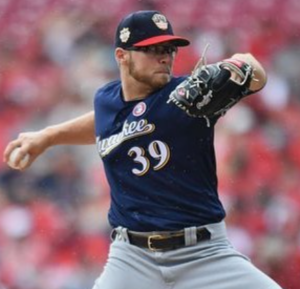Corbin Burnes’ decision to join the Arizona Diamondbacks marks a new chapter in his career and a turning point for the franchise
With his combination of elite talent, strategic adaptability, and leadership, Burnes is poised to make a lasting impact both on and off the field. For Diamondbacks fans, the future has never looked brighter.
From 2021 to 2024, Corbin Burnes demonstrated remarkable adaptability, transitioning from a strikeout-first pitcher to a more balanced and efficient ace.
His ability to adjust his approach in response to changing league dynamics and personal performance trends underscores his resilience and intelligence as a competitor.
While his peak dominance in 2021 remains a standout, his subsequent evolution illustrates the complexities and challenges of sustaining success at the highest level of the game.
Whether overpowering hitters or pitching to contact, Burnes has proven himself to be a versatile and valuable asset to his team.

Also Read: Corbin Burnes: Who Is He? Bio, Wiki, Age, Career, Relationship, Family and More
Table of Contents
Corbin Burnes’ Arizona Diamondbacks Contract
On Wednesday, the Arizona Diamondbacks officially announced the signing of star pitcher Corbin Burnes to a six-year, $210 million contract.1
This monumental deal not only cements Burnes’ status as one of the premier pitchers in Major League Baseball but also signals the Diamondbacks’ commitment to strengthening their roster for future success.
Corbin Burnes, who spent the first part of his career with the Milwaukee Brewers, has consistently been among the top pitchers in the league.
Known for his electrifying stuff, including a devastating cutter, Burnes has established himself as a perennial Cy Young contender. Transitioning to Arizona, Burnes will now lead a pitching staff that has its eyes set on postseason glory.
The Contract: A Statement of Intent
The six-year, $210 million contract represents a major investment by the Diamondbacks. At an average annual value of $35 million, it is one of the largest contracts in franchise history.
The deal underscores Arizona’s intention to compete in the highly competitive National League West, home to powerhouses like the Los Angeles Dodgers and San Diego Padres.
During an interview with MLB Network, Burnes addressed a key question about his performance: the notable decline in his strikeout rate (K/9) from 2021 to 2024.
Over this period, Burnes saw his strikeouts per nine innings drop from an elite 12.61 in 2021 to a more modest 8.39 in 2024. This decrease of 4.22 strikeouts per nine innings raised questions about his approach on the mound.

Corbin Burnes’ Response to the Decline
When asked about the strikeout decline, Burnes provided an insightful explanation. “Yeah, so the main goal this year was to fill up the strike zone more,” Burnes said.2
“We thought we had a lot of room to grow in first-pitch strikes and overall strike percentage. By doing that, we got a lot of early contact, which allowed us to pitch deeper into games and keep the pitch count down.”
This adjustment in strategy—focusing on efficiency rather than pure strikeouts—reflects a maturity in Burnes’ game. As pitchers age, they often seek to conserve their arms by pitching smarter, not harder.
Burnes also noted that he and his team shifted their approach in September to regain some of his “swing-and-miss stuff.” This change aimed to increase his strikeouts while maintaining his improved efficiency.
“Knowing that I can do both is great, and I think it will help me prolong my career and give me different avenues to get outs,” Burnes explained. “Overall, I think it was a good year and a productive one.”
The Evolution of a Pitcher
Burnes’ approach demonstrates the evolution of a modern pitcher. Early in his career, he relied heavily on overpowering hitters with strikeouts.
However, as he gained experience, he recognized the importance of adaptability. By targeting the strike zone and inducing early contact, Burnes has added another dimension to his game—one that prioritizes longevity and team success.
The addition of Burnes gives the Diamondbacks a true ace at the top of their rotation. His ability to pitch deep into games while balancing strikeouts and efficiency will be invaluable.
Moreover, Burnes’ leadership and postseason experience bring a level of credibility to Arizona’s pitching staff that could help the team navigate the challenges of a competitive division.

Corbin Burnes’ Career Achievements
Burnes’ resume speaks for itself. The 2021 Cy Young Award winner, he has been named to multiple All-Star teams and has consistently ranked among the league leaders in ERA, strikeouts, and advanced metrics like FIP and WHIP.3
His cutter is widely regarded as one of the best pitches in baseball, and his ability to command it will be a key factor in his success with the Diamondbacks.
Moving to the NL West presents new challenges for Burnes. He will face lineups loaded with talent, including perennial MVP candidates like Mookie Betts, Freddie Freeman, and Fernando Tatis Jr.
However, Burnes’ adaptability and experience make him well-equipped to succeed in one of baseball’s toughest divisions.
The Impact on Diamondbacks Fans
The signing of Burnes is sure to excite the Diamondbacks fan base. After years of middling performance, this move signals a commitment to winning.
Fans can look forward to watching a bona fide ace take the mound every fifth day, a rare treat for any franchise.
If Burnes performs to expectations, this signing could go down as one of the most impactful in Diamondbacks history.
Beyond his on-field contributions, Burnes has the opportunity to mentor younger pitchers, influence the team’s culture, and help Arizona establish itself as a perennial contender.
Arizona’s 2024 season showed promise, but the team lacked the pitching depth to go deep into October. By signing Burnes, the Diamondbacks are signaling that they intend to be serious contenders in the National League.
His presence not only bolsters their rotation but also alleviates pressure on younger pitchers who can learn from his example.

Also Read: Corbin Burnes: Who Is He? Meet Wife Brooke Burnes, Kids, Career, Net Worth 2024 And More
Corbin Burnes’ Stats from 2021 to 2024
Corbin Burnes’ pitching career reached its peak in 2021 when he emerged as one of the most dominant pitchers in Major League Baseball with the Milwaukee Brewers.
His rapid ascent from a promising prospect to an elite ace highlighted a transformative journey, especially given his limited innings prior to that breakout season.
In this analysis, we’ll examine two critical pitching metrics—strikeout rate (K/9) and walk rate (BB/9)—to understand his evolution as a pitcher from 2021 to 2024.
Strikeout Rate (K/9): Burnes’ Transition from Power to Precision
2021: The Pinnacle of Strikeout Dominance
In 2021, Corbin Burnes showcased his ability to overpower hitters with an elite strikeout rate of 12.61 K/9.
This metric placed him among the league’s best, as he consistently induced swings and misses with his dynamic pitch repertoire, including a devastating cutter and curveball combination.
Burnes’ reliance on his high-spin pitches was a hallmark of his success, enabling him to dominate opposing lineups.
2022: A Noticeable Decline
Burnes’ strikeout rate dropped to 10.83 K/9 in 2022, a notable decline but still an impressive mark. This reduction could be attributed to a strategic shift in his approach.
Burnes began to focus more on inducing weak contact rather than solely seeking strikeouts. This adjustment reflected his growing maturity as a pitcher, prioritizing efficiency over sheer power.
2023: A Further Dip
In 2023, Burnes’ strikeout rate dipped further to 9.30 K/9. This change coincided with a period where hitters appeared to adjust to his pitch selection and sequencing.
While his velocity remained consistent, the effectiveness of his secondary pitches seemed to waver, resulting in fewer strikeouts.
2024: A More Balanced Approach
By 2024, Burnes’ strikeout rate had decreased to 8.39 K/9, marking a significant shift from his 2021 peak. However, this decline was not necessarily indicative of regression.
Instead, it underscored Burnes’ evolution into a more well-rounded pitcher. He leveraged his experience and understanding of hitters to generate outs through a combination of weak contact and ground balls, reducing his reliance on high strikeout numbers.
View this post on Instagram
Walk Rate (BB/9): Fluctuations in Command
2021: Elite Control
In 2021, Burnes’ command was exceptional, as evidenced by his walk rate of 1.83 BB/9. This level of precision allowed him to minimize free passes, keeping hitters off base and enhancing his overall effectiveness.
His ability to pair elite strikeout numbers with such control was a key factor in his dominance that season.
2022: A Slight Uptick
In 2022, Burnes’ walk rate increased to 2.27 BB/9. While this represented a slight decline in his command, it was still well within the acceptable range for a frontline starter.
This marginal rise in walk rate may have been a byproduct of his evolving approach, as he experimented with different pitch locations to induce weak contact.
2023: A Concerning Spike
The 2023 season saw Burnes’ walk rate rise to 3.07 BB/9, the highest of his career during this period. This spike indicated struggles with consistency and command, as he occasionally lost the ability to locate his pitches effectively.
The higher walk rate also led to increased baserunners, which placed additional stress on his performances.
2024: A Return to Stability
Burnes made adjustments in 2024, lowering his walk rate to 2.22 BB/9. This improvement reflected his determination to refine his mechanics and regain his command.
Although his walk rate didn’t return to the elite levels of 2021, it marked a step in the right direction and complemented his broader focus on pitching to contact.

Corbin Burnes: Broader Perspective on Performance
Wins Above Replacement (WAR) provides a comprehensive measure of a player’s overall contribution to their team.
Burnes’ WAR peaked at 5.6 in 2021, underscoring his status as one of the league’s most valuable pitchers that season. However, his WAR gradually declined over the subsequent seasons:
- 2022: 4.4 WAR
- 2023: 3.7 WAR
- 2024: 3.4 WAR
This trend mirrored the decreases in his strikeout rate and the fluctuations in his walk rate. Despite the decline, Burnes remained a reliable and effective pitcher, showcasing his ability to adapt and maintain value even as his approach evolved.
Factors Influencing Burnes’ Evolution
Adjustments to League Trends
As hitters across the league adjusted to Burnes’ strengths, he was forced to adapt his approach.
This included a greater emphasis on pitch sequencing, location, and inducing weak contact rather than relying solely on overpowering stuff. His ability to adjust to these trends highlighted his baseball IQ and commitment to staying competitive.
Durability and Workload
Burnes’ increased workload also played a role in his statistical trends. With more innings pitched each season, the physical and mental demands of being a staff ace became more pronounced.
Managing these challenges while maintaining effectiveness required a shift in his pitching style.
Development of Secondary Pitches
While Burnes’ cutter remained his signature pitch, he continued to refine his secondary offerings, including his changeup and slider.
These pitches became more integral to his repertoire as he moved away from a strikeout-heavy approach, providing him with additional tools to navigate lineups.
Also Read: Rafael Devers: Boston’s Missed Opportunities, Future Prospects and More




